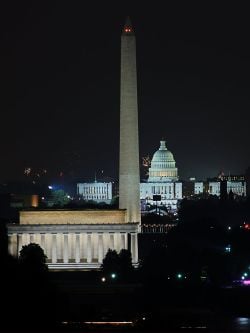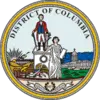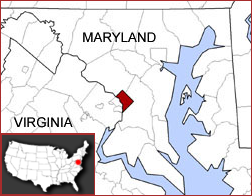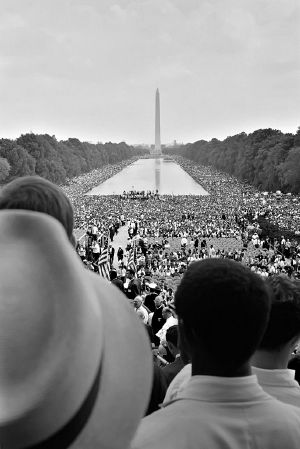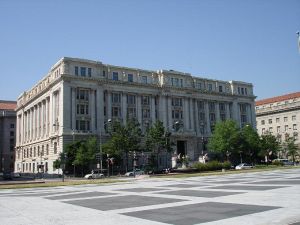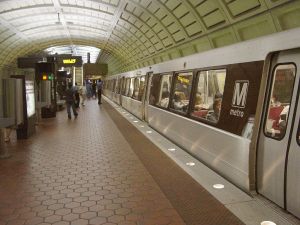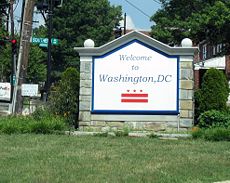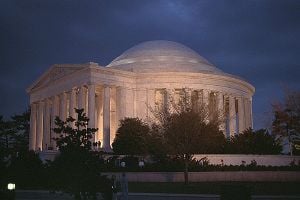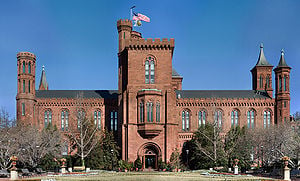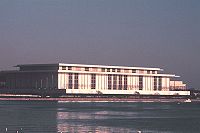Washington, D.C.
| Washington, D.C. | |||
|
|||
| Nickname: DC, The District | |||
| Motto: Justitia Omnibus (Justice for All) | |||
| Location of Washington, D.C., in relation to the states Maryland and Virginia | |||
| Coordinates: {{#invoke:Coordinates|coord}}{{#coordinates:38|53|42.4|N|77|02|12.0|W|type:city | |||
|---|---|---|---|
| name= }} | |||
| Country | United States | ||
| Federal District | District of Columbia | ||
| Government | |||
| - Mayor | Adrian M. Fenty (D) | ||
| - D.C. Council | Chairperson: Vincent C. Gray (D) Ward 1: Jim Graham (D) |
||
| Area | |||
| - City | 68.3 sq mi (177.0 km²) | ||
| - Land | 61.4 sq mi (159.0 km²) | ||
| - Water | 6.9 sq mi (18.0 km²) | ||
| Elevation | 0–410 ft (0–125 m) | ||
| Population (2006)[1] [2] | |||
| - City | 581,530 | ||
| - Density | 9,015/sq mi (3,481/km²) | ||
| - Metro | 8,207,040 (est 2,006) | ||
| Time zone | EST (UTC-5) | ||
| - Summer (DST) | EDT (UTC-4) | ||
| Website: http://www.dc.gov/ | |||
Washington, D.C., is the capital city of the United States of America. "D.C." is an abbreviation for the District of Columbia, the federal district coextensive with the city of Washington. The city is named after George Washington, military leader of the American Revolution and the first president of the United States. Columbia in this context is an early poetic name for the United States of America, a reference to Christopher Columbus, an early European explorer of the Americas.
The city is commonly referred to as Washington, The District, or simply D.C. In the nineteenth century, it was called the Federal City or Washington City.
The centers of all three branches of the U.S. federal government are in the District. It also serves as the headquarters for the World Bank, the International Monetary Fund, the Organization of American States, the Inter-American Development Bank, and other national and international institutions including labor unions and professional associations.
Washington is the frequent location of political demonstrations and protests, large and small, particularly on the National Mall. Furthermore, Washington is a popular destination for tourists, the site of numerous national landmarks and monuments. It is a major American cultural center, with a number of important and free museums including the world's largest museum complex (the Smithsonian Institution), galleries, universities, cathedrals, performing arts centers and institutions, and native music scenes.
Although there is a municipal government and a mayor, Congress has the supreme authority over the city and district, which results in citizens having less self-governance than residents of states. The District also does not have voting representation in Congress.
While the population of the District of Columbia is about 581,530 persons, the entire metropolitan area is the eighth largest in the United States with more than five million residents. If one includes the Baltimore metropolitan area, the population exceeds eight million.
Geography
Topography

The city has a total area of 68.3 square miles (177.0 km²). It is surrounded by the states of Maryland (on its southeast, northeast, and northwest sides) and Virginia (on its western side). The Potomac River as it passes Washington is virtually entirely within the District of Columbia border. The Anacostia River and Rock Creek are tributaries of the Potomac.
The highest point in the District of Columbia is 410 feet (125 m) above sea level at Tenleytown. The lowest point is sea level, which occurs along the Anacostia and Potomac shores.

Climate
Washington's climate is typical of the Mid-Atlantic states, with four distinct seasons. Summer tends to be hot and humid with daily high temperatures in July and August averaging in the high 80s to low 90s F (30° to 33° C). The combination of heat and humidity makes thunderstorms frequent in the summer, some of which occasionally produce tornadoes. Spring and fall are mild, with high temperatures in April and October averaging in the high 60s to low 70s (about 20 °C). Winter brings sustained cool temperatures and occasional heavy snow, though light snowfall is more common. Average highs tend to be in the low 40s (6 to 8 °C) and lows in the mid 20s (-5 to -2 °C) from mid-December to mid-February. Spring is generally the most favorable time of year, with low humidity, mild temperatures, and blooming foliage. This period generally lasts from late March until mid May.
Nature
Washington, D.C. has many natural areas and bird watching spots inside the city. D.C.'s parks and natural areas include the United States National Arboretum, the extensive Rock Creek Park, the Smithsonian National Zoological Park, Theodore Roosevelt Island, the C&O Canal, the Potomac River, and the Anacostia River.
The Potomac has been called one of the wildest urban rivers in the nation. Once called a national disgrace by President Lyndon B. Johnson, it is now home to a vibrant warm water fishery. Professional bass tournaments have been held within view of the Jefferson Memorial, and naturally reproducing bald eagles have returned to its banks.
History
The District of Columbia, founded on July 16, 1790, is a federal district as specified by the United States Constitution. The U.S. Congress has ultimate authority over the District of Columbia, though it has delegated considerable authority to the municipal government. The land forming the original District came from the state of Maryland and Commonwealth of Virginia. However, the area south of the Potomac River (39 square miles or about 100 km²) was returned to Virginia in 1847 and now is incorporated into Arlington County and the city of Alexandria. After 1847, the remaining land that formed the area now known as the District of Columbia was formed exclusively from land that once belonged to Maryland.
Planning
A southern site for the new country's capital was agreed upon as part of the deal that led to the national government's assumption of debts from the Revolutionary War. (The southern states had largely paid off their war debts; collectivizing debt was to the northern states' advantage, so a southern capital was a compromise.) The city's plan was largely the work of Peter (Pierre) Charles L'Enfant, a French-born architect, engineer, and city planner who first arrived in the American colonies as a military engineer with Major General Lafayette. L'Enfant drew up a basic plan for Washington, D.C., in 1791; the city's layout owed much to the Baroque style, which was the dominant style in many North American and European planned cities of the day. The plan incorporated broad avenues and major streets that radiate out from traffic circles, providing vistas toward important landmarks and monuments. While all the original colonies had avenues named for them, the most prominent states received more prestigious locations. Pennsylvania Avenue was given the honor of connecting the White House to the planned Capitol building.
The actual site on the Potomac River was chosen by President George Washington. The city was officially named "Washington" on September 9, 1791. George Washington never referred to it as such, preferring to call it "the Federal City."
The federal district was named the District of Columbia because Columbia was a poetic name for the United States at the time, which was close to the 300th anniversary of Christopher Columbus' first voyage to the Americas in 1492.
In 1791–1792, Andrew Ellicott and Benjamin Banneker surveyed the border with both Maryland and Virginia, placing boundary stones at every mile point; many of these still stand.
Nineteenth century
On August 24, 1814, Canadian forces under British command burned the capital during the most notable raid of the War of 1812 in retaliation for the sacking and burning of York (modern-day Toronto) during the winter months, which had left many Canadians homeless. President James Madison and U.S. forces fled before the British forces arrived and burned public buildings, including the Capitol and the Treasury building. The White House was burned and gutted. The Washington Navy Yard was also burned — by American sailors — to keep ships and stores from falling into the hands of the British. The home of the Commandant of the Marine Corps, located at the Marine Barracks, was one of the few government buildings not burned by the raiding British soldiers out of a sign of respect and is now the oldest public building in continuous use in the nation's capital. The Patent Office was also spared, as a result of the Superintendent of Patents pleading with British soldiers and contending that destroying the store of knowledge therein would be a disservice to mankind.
During the 1830s, the District was home to one of the largest slave trading operations in the country.
In 1846, the population of Alexandria County, who resented the loss of business with the competing port of Georgetown and feared greater impact if slavery were outlawed in the capital, voted in a referendum to ask Congress to cede Alexandria back to the Commonwealth of Virginia. Congress agreed to do so. The slave trade, though not slavery, in the capital was outlawed as part of the Compromise of 1850.
Washington remained a small city — the 1860 census put the population at just over 75,000 persons — until the outbreak of the Civil War in 1861. The significant expansion of the federal government to administer the war and its legacies, such as veterans' pensions, led to notable growth in the city's population, as did a large influx of freed slaves. By 1870, the District's population had grown to nearly 132,000.
In July 1864, Confederate forces under General Jubal Anderson Early made a brief raid into Washington, culminating in the Battle of Fort Stevens. The Confederates were repelled, and Early eventually returned to the Shenandoah Valley. The fort is located near present day Walter Reed Army Medical Center in northwest Washington. This was the only battle where a U.S. president, Abraham Lincoln, was present and under enemy fire while in office.
In the early 1870s, Washington was given a territorial government, but Governor Alexander Robey Shepherd's reputation for extravagance resulted in Congress abolishing his office in favor of direct rule. Congressional governance of the District would continue for a century.
In 1878, Congress passed an Organic Act that made the boundaries of the city of Washington coterminous with those of the District of Columbia. This effectively eliminated Washington County; Georgetown, technically made a part of the city, was allowed to remain nominally separate until 1895 when it was formally combined with Washington.
The Washington Monument, with construction stalled by other priorities, finally opened in 1888. Plans were laid to further develop the monumental aspects of the city, with work contributed by such noted figures as Frederick Law Olmsted and Daniel Burnham. However, development of the Lincoln Memorial, Jefferson Memorial and other structures on the National Mall, and construction of Potomac Park did not begin until the early 20th century.
20th century
The many Depression relief agencies created by Franklin Roosevelt's New Deal, followed by World War II, brought a great increase to the city's population. The District's population peaked in 1950, when the census for that year recorded a record population of 802,178 people.[3] At the time, the city was the ninth-largest in the country. The population declined in the following decades, mirroring the suburban emigration from many of the nation's older urban centers following World War II and the racial integration of public schools.
The Twenty-third Amendment to the United States Constitution was ratified on March 29, 1961, allowing residents of Washington, D.C., to vote for president and have their votes count in the Electoral College as long as Washington, D.C., does not have more electoral votes than the least populous state.
After the assassination of civil rights activist Martin Luther King, Jr., in Memphis, on April 4, 1968, riots broke out in some sections of the city. The violence raged for four days, and buildings were burned. At one point, the rioters came within two blocks of the White House. President Lyndon B. Johnson ordered over 13,000 federal troops to occupy the city—the largest occupation of an American city since the Civil War. It took years for the city to recover.
One of the most important developments in bringing people back downtown was the building of the subway system. The first 4.6 miles (7.4 km) of the Washington Metro subway system opened on March 27, 1976. Today the system knits together Washington and its suburbs with a network of 86 stations and 106.3 miles (171.1 km) of track.
In 1973, Congress enacted the District of Columbia Self-Rule and Governmental Reorganization Act, providing for an elected mayor and council for the District. As a result, Walter Washington became the first elected mayor of the District in 1975. Marion Barry became mayor in 1979 and served three successive terms; however, after his arrest for drug use in an FBI sting operation on January 18, 1990, and his sentence to a six-month jail term, he did not seek re-election. His successor, Sharon Pratt Kelly, became the first black woman to lead a U.S. city of Washington's size and importance. Barry, however, ran again in 1994, defeating her in the Democratic primary and once again becoming mayor. During his fourth term, the city nearly became insolvent and was forced to give up some home rule to a congressionally-appointed financial control board. In 1998, Anthony A. Williams was elected the city's mayor and led the city into a fiscal recovery. In 2006, Adrian Fenty was elected mayor. Among Mayor Fenty's many promises are increased attention to every citizen of the city and a world class atmosphere in business and residence.
During the 1970s, Many in the District referred to it as "Chocolate City," in honor of the city's African-American culture and to promote cultural awareness. Popularized by two local disk jockeys, the nickname was also a reference to the 1975 album "Chocolate City" by Parliament-Funkadelic. While the nickname never caught on permanently, it was a poignant reminder of the contributions to the city over the years by such icons as Duke Ellington, Chuck Brown, and other African-American performers.
21st century
On September 11, 2001, a hijacked aircraft deliberately crashed into the Pentagon, just across the Potomac River in Arlington, Virginia, causing a partial collapse of one side of the building. Al-Qaeda leader Abu Zubaydah told American officials while under interrogation that the White House was the intended target,[4] while Khalid Sheikh Mohammed and Ramzi Binalshibh have said that the United States Capitol Building was the intended target[5] of the hijacked United Airlines Flight 93.
On September 29, 2004, Major League Baseball officially relocated the Montreal Expos to Washington for the 2005 season, despite opposition from Baltimore Orioles owner Peter Angelos. The new team was christened the Washington Nationals. Controversy between the city council and MLB threatened to scuttle the agreement until December 21, 2004 when a plan for a new stadium in Southeast D.C. was finalized. The Nationals will play at R.F.K. Stadium until the new stadium is ready on the Anacostia River waterfront in 2008.[6]
Additionally, the city has experienced tremendous growth in the areas of Massachusetts Avenue, NoMa (North of Massachusetts), the Southwest Waterfront, the Shaw/U Street Corridor and H Street, with tens of thousands of condos, apartments and retail shops opening. This growth has been dubbed gentrification by many, as the areas experiencing growth had been blighted for many years prior.
Law and government
Local government
The city is run by an elected mayor (Adrian Fenty) and a district council. The council is composed of 13 members: one elected from each of the eight wards and five members, including the chairman, elected at large. The council conducts its work through standing committees and special committees established as needed. District schools are administered by a school board that has both elected and appointed members. There are 37 elected Advisory Neighborhood Commissions that provide the most direct access for residents to their local government. The commissions serve as local councils, and their suggestions are required to be given "great weight" by the D.C. Council. However, the U.S. Congress has the right to review and overrule laws created locally and has often done so.
D.C. residents pay federal taxes, such as income tax, as well as very high local taxes. The mayor and council adopt a budget of local money with Congress reserving the right to make any changes. Much of the valuable property in the District is federally owned and hence exempt from local property taxes; at the same time, the city is burdened with the extraordinary expenses related to its role as the capital, such as police overtime and street cleaning for D.C.'s frequent parades and festivals. These factors are often used to explain why the city's budget is frequently overstretched. However, the federal government also appropriates funds for the city. For instance, the federal government provided an estimated 25 percent of the District's operating budget in 2003.
Representation in federal government
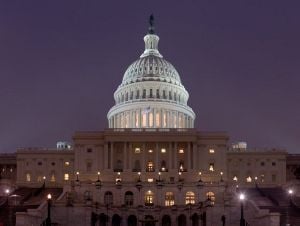
The U.S. Constitution gives Congress direct jurisdiction over Washington, D.C. While Congress has delegated various amounts of this authority to local government, including an elected mayor and city council, Congress still intervenes, from time to time, in local affairs relating to schools, gun control policy, and other issues.
Citizens of the District have no voting representation in Congress. They are represented in the House of Representatives by a non-voting delegate (Eleanor Holmes Norton) who sits on committees and participates in debate but cannot vote. D.C. has no representation in the Senate. Attempts to change this situation, including statehood and the proposed District of Columbia Voting Rights Amendment, have been unsuccessful. However, unlike U.S. territories (such as American Samoa and Guam), citizens of the District of Columbia are fully taxed and subject to all U.S. laws. In recent years, "Taxation Without Representation" has been the motto placed on D.C. license plates.
With the passage of the 23rd Amendment in 1961, residents of the District became eligible to vote for president. They voted overwhelmingly for Barack Obama in the 2008 elections.
Domestic partnerships
The District of Columbia has recognized domestic partnerships since 1992, but Congress withheld funding to implement recognition until 2002. Both same-sex and mixed-sex couples may register. Under the Domestic Partnership Equality Amendment Act of 2006, D.C. Law 16-79, which came into effect on April 4, 2006, in almost all cases a domestic partner will have the same rights as a spouse regarding inheritance, probate, guardianship, and other rights traditionally accorded to spouses. Employees of the District government and their domestic partners are eligible for healthcare coverage and family leave benefits, the same as married couples.
Crime
During the violent crime wave of the early 1990s, Washington, D.C., was known as the "murder capital" of the United States,[7] and often rivaled New Orleans in the high number of homicides. Homicides peaked in 1991 at 482, but the level of violence declined drastically in the 1990s. In 2007, there were 181 murders, up from 169 in 2006. As of December 16, 2008, the total was up 4 percent over the previous year on that date.[8] Some neighborhoods are becoming safe and vibrant areas as a result of gentrification. Crime hot spots have been displaced farther into the eastern sections of Washington, D.C., and across the border into Maryland. Although the southeastern side of the city has developed a reputation for being unsafe, these crime hot spots are generally concentrated in very specific areas that are associated with drugs and gangs.[1] Other areas east of the U.S. Capitol, as well as the city's wealthier Northwest neighborhoods west of Rock Creek Park, experience low levels of crime. Despite the declining trends, the city's crime rates (2005) remain among the highest of U.S. cities, and it was most recently ranked as the 13th most dangerous city in the nation (2005). Washington, D.C.'s crime rate surpasses the rates of Los Angeles and New York.[9]
Economy
Washington, D.C., has a growing economy that is also diversifying, with a decreasing percentage of federal government jobs expected over the next decade and an increasing percentage of professional and business service jobs over the same period.[10] With five Fortune 1000 companies (two of which are also Fortune 500 companies)[11], and a large support infrastructure of professional services, including law, public relations, and architecture, Washington, D.C., has become a leading city for global real estate investment, behind London, New York City, and Paris.
As of 2002, the federal government accounted for 27 percent of Washington, D.C.'s jobs.[12] The presence of many major government agencies has led to business development in the region [2]. These businesses include federal contractors (defense and civilian), numerous nonprofit organizations, law firms and lobbying firms, national associations of labor and professional groups, catering and administrative services companies, and other industries that are sustained by the economic presence of the federal government.
The gross state product of the District in 2006 was $87.664 billion, ranking it No. 35 when compared with the fifty states.[13] In 2006, Expansion magazine ranked it among the top 10 metropolitan areas in the nation for climates favorable to business expansion.[14]
Other than the government, major universities and hospitals are among the top employers with the George Washington University, Georgetown University, and Washington Hospital Center as the top three.
Insurance and banking
Washington, D.C.'s financial regulatory environment becoming more competitive as a jurisdiction for captive insurance companies and financial institutions to locate and do business. This increasingly popular form of alternative insurance allows large corporations and industry associations to create independent insurance companies to insure their own risks. Since 2001, Washington, D.C.'s Department of Insurance, Securities and Banking has licensed over 70 companies.[15]As of 2006, Washington, D.C. is the world's fifteenth-largest and the USA's sixth-largest domicile for captive insurance companies, according to the Insurance Information Institute.[16]
Transportation
Several major interstates run through the area, intersecting with other major highways. The American Automobile Association for several years has ranked the Washington metro area as having the nation's second worst traffic congestion, surpassed only by Los Angeles'.
The Washington area is served by the Washington Metropolitan Area Transit Authority, which operates the region's subway system, the nation's second-busiest after New York's subway, as well as Metrobus, which serves D.C. and the immediate closest counties.
Washington, D.C., is served by three major airports, one in Maryland and two in Virginia. Ronald Reagan Washington National Airport is the closest and is accessible by the Washington Metro. Most major international flights arrive and depart from Washington Dulles International Airport, located 26.3 miles (42.3 km) west of the city in Virginia. Dulles is the second busiest international gateway on the East Coast. Baltimore-Washington International Thurgood Marshall Airport is located 31.7 miles (51.0 km) northeast of the city near Baltimore, Maryland.
Demographics
In 2007, the population distribution was 55.6% black, 36.3% white, 8.3% Hispanic (of any race), 5% other (including Native Americans, Alaskans, Hawaiians, and Pacific Islanders), 3.1% Asian, and 1.6% mixed (two or more races).[17] Even though they compose the city's largest ethnic group, Washington has a steadily declining black population, due to many African Americans leaving the city for suburbs. At the same time, the city's white population has steadily increased, in part due to effects of gentrification in many of Washington's traditionally black neighborhoods.[18] This is evident in a 7.3% decrease in the African American population, and a corresponding 17.8% increase in the Caucasian population since 2000.[19] In 2007, there were an estimated 74,000 foreign immigrants living in Washington, D.C.[17] Major sources of immigration include El Salvador, Vietnam, and Ethiopia, with some concentration of Salvadorans in the Mount Pleasant neighborhood.[20]
The 2000 census revealed that an estimated 33,000 adults in the District of Columbia identify as gay, lesbian, or bisexual, about 8.1% of the city's adult population.[21] Despite the city's sizable LGBT population and liberal political climate, same-sex marriage is not legal in the District, due in part to opposition in Congress.[22] However, Washington's domestic partnership law does provide same-sex couples legal recognition similar to civil unions offered in other jurisdictions.[22]
The 2005 Census Bureau estimate of the city's population was 582,049. After the city government questioned the original results – an estimate of 550,521 – the Census Bureau revised the estimate.[23] The revised figure marked the first increase in the city's population since 1950.
As of the 2000 census, there were 572,059 people, 248,338 households, and 114,235 families residing in the city. The population density was 9,316.4 per square mile (3,597.3/km²). There were 274,845 housing units at an average density of 1,728.3/km² (4,476.1/mi²). The largest Hispanic group is Salvadoran, accounting for an estimated 18,505 of Washington's 45,901 Hispanic population.[24] D.C. has a steadily declining African American population, due to many middle-class and professional African Americans moving to the suburbs, aggravated by the rising cost of living in the area. African Americans account for about 57 percent of the population.
There were 248,338 households, out of which 19.8% had children under the age of 18 living with them, 22.8% were married couples living together, 18.9% had a female householder with no husband present, and 54.0% were non-families. 43.8% of all households were made up of individuals and 10.0% had someone living alone who was 65 years of age or older. The average household size was 2.16 and the average family size was 3.07.
In the city, the population was spread out, with 20.1% under the age of 18, 12.7% from 18 to 24, 33.1% from 25 to 44, 21.9% from 45 to 64, and 12.2% who were 65 years of age or older. The median age was 35 years. For every 100 females there were 89.0 males.
According to the Census Bureau, the District's daytime population is estimated at 982,853.[25] The influx of over 410,000 workers into Washington on a normal business day comprises a 72 percent increase of the capital's normal population. That is the largest increase percentage-wise of any city studied and the second-largest net increase, behind only New York City.
The Greater Washington metropolitan area, including contiguous areas of Maryland and Virginia, had an estimated population of 5.8 million in 2003, according to the estimates of the Greater Washington Initiative.
The median income for a household in the city was $40,127, and the median income for a family was $46,283. Males had a median income of $40,513 versus $36,361 for females. The per capita income for the city was $28,659. About 16.7% of families and 20.2% of the population were below the poverty line, including 31.1% of those under age 18 and 16.4% of those over age 65. According to Forbes magazine it is the ninth wealthiest city in the country based on median household income, with over half of its residents having an income of $46,500 a year, and the average home price being $429,900.[26]
Literacy
A 2007 report found that approximately one-third of the population in Washington, D.C., is functionally illiterate, compared to a rate of about one-fifth nationally.[27] One of the primary reasons is the high growing number of Hispanic and Ethiopian immigrants, many of whom are not proficient in English. On the other hand, over 45 percent of residents have a college degree or higher, and the city ranks fourth in the nation with that educational attainment.[28] A 2000 study shows that 83.42% of Washington, D.C. residents age 5 and older speak only English at home and 9.18% speak Spanish. French is the third most spoken language at 1.67%.[29]
According to the 2001 American Religious Identification Survey, nearly three-fourths of District residents identified themselves as Christian. This breaks down to 72% Christian (27% Catholic, 19% Baptist, and 26% other Protestant churches), 13% stating no religion, 4% Buddhist, 2% Muslim, and 1% Jewish.
As host to over 180 embassies and hundreds of international organizations, Washington, D.C. has a substantial population of foreign residents. There are also many students from abroad studying at the local universities and colleges. This adds a cosmopolitan flavor to the city.
Education
District of Columbia Public Schools (DCPS) operates the city's public school system, which consists of 167 schools and learning centers. In the 2007–08 school year, 49,076 students were enrolled in the public school system. Enrollment in DCPS has been steadily decreasing, and by next year the city expects total enrollment to fall to 47,700.[30] DCPS has one of the highest-cost yet lowest-performing school systems in the country, both in terms of infrastructure and student achievement.[31] Mayor Adrian Fenty's new superintendent of DCPS, Chancellor Michelle Rhee, has made sweeping changes to the system by closing schools, replacing teachers, firing principals, and using private education firms to aid curriculum development.[32]
Due to the problems with the D.C. public school system, enrollment in public charter schools has increased 13% each year since 2001.[33] The District of Columbia Public Charter School Board monitors the 56 public charter schools in the city. As of fall 2007, D.C. charter schools had a total enrollment of 21,859.[34] The District is also home to some of the nation's top private schools. In 2006, approximately 18,000 students were enrolled in the city's 83 private schools.[35]

Washington is home to many notable universities, including The George Washington University (GW), Georgetown University (GU), American University (AU), The Catholic University of America (CUA), Howard University, Gallaudet University, and The Johns Hopkins University School of Advanced International Studies (SAIS). The University of the District of Columbia (UDC) provides public postsecondary education. It is the nation's only urban land-grant university and is counted among the historically black colleges and universities.
Colleges and universities
The city is home to several universities, colleges, and other institutions of higher education, both public and private. The University of the District of Columbia is the city's public university; it is the nation's only urban land-grant university and is counted among the historically black colleges and universities.
Among private institutions, Georgetown University is older than the District itself, having been founded in 1789. It is the nation's oldest Roman Catholic-affiliated body of higher education. The university is especially well-known for the Edmund Walsh School of Foreign Service and the Georgetown University Law Center.
George Washington University, founded by an act of Congress in 1821, is the largest institution of higher education in the nation's capital. Known for the Elliott School of International Affairs, as well as the The George Washington University Law School and its School of Business, it is the second-largest landholder and employer in the District, second only to the federal government. American University, a private institution chartered by an act of Congress in 1893, is situated on an 84-acre (34 ha) campus in upper Northwest Washington. The Catholic University of America (CUA) is unique as the national university of the Roman Catholic Church and as the only higher education institution founded by U.S. Roman Catholic bishops. Established in 1887 following approval by Pope Leo XIII as a graduate and research center, the university began offering undergraduate education in 1904.
Other notable private colleges in the District include Gallaudet University, the first liberal arts college for the deaf and hard-of-hearing, Howard University, a historically black university dating to the nineteenth century which among other achievements trained many early black physicians, and Southeastern University, a smaller institution with a concentration in business studies.
Culture
Tourism
Washington is home to numerous national landmarks and is one of the most popular tourist destinations in the United States. The National Mall is a large, open park area in the center of the city featuring many monuments to American leaders; it also serves to connect the White House and the United States Capitol buildings. Located prominently in the center of the Mall is the Washington Monument. Other notable points of interest near the Mall include the Jefferson Memorial, Lincoln Memorial, Franklin Delano Roosevelt Memorial, National World War II Memorial, Korean War Veterans Memorial, and Vietnam Veterans Memorial.
The world-famous Smithsonian Institution is based in the District. The Smithsonian today is a collection of museums that includes the Arthur M. Sackler Gallery, Hirshhorn Museum, National Air and Space Museum, National Museum of American History, National Museum of the American Indian, National Museum of Natural History, National Portrait Gallery, and National Zoo.
There are many art museums in D.C., in addition to those that are part of the Smithsonian, including the National Gallery of Art, National Museum of Women in the Arts, Corcoran Gallery of Art, and Phillips Collection.
The Library of Congress and the National Archives house thousands of documents covering every period in American history. Some of the more notable documents in the National Archives include the Declaration of Independence, Constitution and Bill of Rights.
Other points of interest in the District include Arena Stage, Chinatown, Basilica of the National Shrine of the Immaculate Conception, Blair House, Folger Shakespeare Library, Ford's Theatre, Frederick Douglass National Historic Site, National Building Museum, National Geographic Society, Theodore Roosevelt Island, United States Holocaust Memorial Museum and the Washington National Cathedral.
Performing arts
Washington is a major national center for the arts, with many venues for the performing arts in the city. Arena Stage, one of the first non-profit regional theaters in the nation, produces an eight-show season ranging from classics to world premieres. The Shakespeare Theatre Company is regarded as one of the world's great Shakespeare troupes. Numerous other professional theaters, such as the Studio Theatre and Woolly Mammoth, and venues such as the National Theatre, make the city a major theater center. The John F. Kennedy Center for the Performing Arts hosts the National Symphony Orchestra, the Washington National Opera, the Washington Ballet, and a variety of other musical and stage performances.
The Lincoln Theatre on U Street (known as "Washington's Black Broadway" prior to the 1968 riots) once hosted the likes of Duke Ellington and Ella Fitzgerald. Several notable local music clubs are all in the U Street area.
D.C. has its own native music genre, called go-go, a post-funk, percussion-driven flavor of R&B that blends live sets with relentless dance rhythms, so-called because they "go and go and go." Washington was also an important center in the genesis of punk rock in the United States. The region also has a significant indie rock history.
Television
Several television series have featured the District. Most of these have been related to government (The West Wing and Commander in Chief) or security organizations (The District, Get Smart, and, most famously, The X-Files). Other programs had the nation's capital as a secondary focus, using it merely as a city setting. The sitcom 227 portrayed the life of the African American majority as seen through the eyes of residents in a Washington apartment building. Many movies are filmed in the city yearly.
Sports
| Club | Sport | League | Venue |
|---|---|---|---|
| D.C. United | Soccer | Major League Soccer, Eastern Conference | RFK Stadium |
| Washington Capitals | Hockey | NHL, Eastern Conference, Southeast Division | Verizon Center |
| Washington Mystics | Basketball | WNBA, Eastern Conference | Verizon Center |
| Washington Nationals | Baseball | Major League Baseball; NL, East Division | RFK Stadium |
| Washington Redskins | Football | National Football League; NFC, East Division | FedExField (Landover, Maryland) |
| Washington Wizards | Basketball | NBA; Eastern Conference, Southeast Division | Verizon Center |
Washington hosts the annual Legg Mason Tennis Classic tennis tournament. The Marine Corps Marathon and the National Marathon are both held annually in Washington.
Media
Newspapers
The Washington Post is the oldest and most-read daily newspaper in Washington. The more conservative daily The Washington Times also has substantial readership. Several specialty newspapers serve the U.S. Congress; most notable are Roll Call and The Hill.
Television
The metro area is served by several local broadcast television stations and is the eighth largest designated market area, with 2,252,550 homes (2.04 percent of the U.S. population). Most Baltimore area television stations can be seen in the Washington region.
Several cable television networks have their headquarters in the Washington area, including C-SPAN, Black Entertainment Television (BET), National Geographic Channel, and Discovery Communications, as well as the Public Broadcasting Service (PBS) in Virginia. Major national broadcasters and cable outlets including NBC, ABC, CBS, FOX, and CNN maintain a significant presence in Washington, as do those from around the world including the BBC, CBC, and Al Jazeera.
Radio
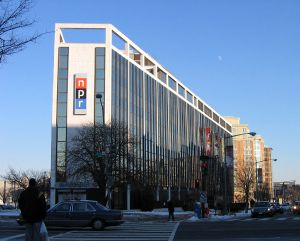
There are several major radio stations serving the metro area, with a wide variety of musical interests as well as talk and sports. WOL 1450 AM, WKYS 93.9 FM, and WMMJ 102.3 are owned by Washington's Radio One, the largest African American media conglomerate in the country. It was founded by Cathy Hughes, a prominent figure in Washington radio since her days at Howard University's WHUR. There are two National Public Radio (NPR) affiliates. Most major radio stations from Baltimore can be heard in the Washington metropolitan area.
XM Satellite Radio and NPR are based in Washington. Voice of America, the U.S. government's international broadcasting service, is headquartered in Washington.
Health care
A prominent hospital in Washington, D.C. is Walter Reed Army Medical Center, the U.S. Army's premier medical center on the East Coast. The 5,500-bed Walter Reed provides care for dependents, active-duty, and retired personnel from all branches of the armed forces, as well as the president, vice president, and congressmen. The hospital is scheduled to move to a newer and larger facility in nearby Bethesda, Maryland, forcing its closure in 2011.
Armed Forces veterans also receive care at the Veterans' Affairs Medical Center.
Washington Hospital Center is the largest hospital campus in the District and both the largest private and largest non-profit hospital in the metropolitan area. It is consistently ranked among the top hospitals in the United States. Immediately adjacent to the Washington Hospital Center campus are the National Rehabilitation Hospital, and Children's National Medical Center (although Children's has satellite centers scattered across the city). Both are among the highest-ranked hospitals in the nation.
Three of the universities in Washington have associated medical schools — and, subsequently, hospitals: George Washington, Georgetown, and Howard University. The oldest continuously operating hospital in the city is Providence Hospital, chartered by Abraham Lincoln in 1861. There are also three private, non-profit community hospitals: Sibley Memorial Hospital in upper Northwest, Hadley Memorial, a long-term acute-care facility in lower Southwest, and Greater Southeast Community Hospital in Southeast, which generally serves the population east of the Anacostia River.
Until 2001, D.C. General Hospital operated near Capitol Hill as the city's only public health-care facility. Mayor Anthony A. Williams had the hospital (which lost several million dollars a year) shut down in an attempt to manage the city's recovery from bankruptcy. The majority of its patient base has since been picked up by Greater Southeast and Prince George's Hospital in Maryland. Mayor Williams in 2005 proposed a new state-of-the-art facility, the National Capital Medical Center, be built on the D.C. General campus as a joint project of the city and Howard University. However, higher-than-expected cost analyses and questions about the proposed hospital's public-health-care capacity caused support for the project to dwindle rapidly.
Looking to the future
Washington has some of the highest-cost, lowest-quality services in the entire region, including a high-cost school system with excessive administrative staff but shabby schools and low learning standards. Prosperity in the late 1990s and early 2000s including an influx of young professional residents, lessened public pressure on the mayor, but he still faced daunting urban renewal, public health, and public education challenges.
A 2007 study found that one-third of adults in the city are functionally illiterate (compared to one-fifth nationally), although Washington still ranks as one of the most educated cities in the nation, with 39 percent of adults holding a bachelor's degree. Recent Central American and Ethiopian immigrants not yet proficient in English contribute to the illiteracy rate, but do not account for all of it. The State of Adult Literacy Report also indicated that funds for literacy programs were misallocated and often not reaching those who most need help, a situation that needs to be remedied. The D.C. Chamber of Commerce said up to $107 million is being lost in tax revenue each year because of a lack of qualified job applicants. While DC has a higher percentage of individuals at the lowest literacy levels than any other state in the nation, a fairer comparison is with other major U.S. cities.In the D.C. study, adults 65 and over have the highest rates of illiteracy. Growing rates of Hispanic and Ethiopian immigrants with poor English skills contribute to the problem.
The high rates of functional illiteracy are especially troubling in D.C. because 47% of the jobs there require college or advanced degrees (as compared with only 26% of the jobs nationally).
The HIV rate in Washington, D.C., our nation’s capital, is 1 in 20—the same as the overall rate in sub-Saharan Africa.the U.S. capital the dubious distinction of having the highest AIDS infection rate of any city in the U.S.
The report, which examined those who live in the District of Columbia, found the disease to be infecting people at an epidemic rate, including an increase in the number of infants, older adults, women, and heterosexual men who have contacted the disease.
According to the new report, more than 12,400 people in D.C. are living with either HIV or AIDS, translating to about 1 person out of every 50 being infected.
Washington D.C. is home to approximately 500,000 people, with African Americans accounting for over half of the population, at around 57 percent. However, black residents account for 81 percent of the city's new infection cases, and about 86 percent of those currently living with the disease.
But, African Americans are not the only group to be targeted in the spread of the HIV/AIDS virus. Researchers found that the number of new H.I.V. cases among men and women ages 40 to 49 has increased dramatically since 2004, as well as the number who become infected through heterosexual contact. Nearly 37 of the new cases detected became infected after heterosexual contact, compared to the 25 percent of cases attributable to men having sex with men.
Dr. Shannon Hader, head of the city's HIV/AIDS Administration, says the city has slowly begun confronting the problem, including voluntary screening to all incoming prison inmates, increased the locations of free screenings to city residents, and initiated a free condom distribution program.
All the other goals associated with ensuring there is any room at all for a middle class in the District — redevelopment, affordable housing, smart growth — none of it can possibly matter if we have to import workers from outside our borders. White households typically have incomes nearly twice that of black or Hispanic families in D.C., and the vast majority of the college degree holders in this city are white.
2004a $20 million, three-year program to help at least 10,000 District residents achieve their learning goals
As of 2008, Washington still lacked a law allowing mothers to drop off infants at hospitals anonymously without facing prosecution.
The safety and quality of tap water is marginal, with unsafe levels of chlorine and lead in water provided to many parts of the city.
ReferencesISBN links support NWE through referral fees
- ↑ Cite error: Invalid
<ref>tag; no text was provided for refs namedCensusEst - ↑ Washington Post. Population Revision 'Big Deal' For D.C.. Retrieved 2006-07-26.
- ↑ "Anniversary of Washington, D.C., as Nation’s Capital." United States Census Bureau (Facts for Features). December 1, 2003. Retrieved on April 28, 2006.
- ↑ "White House target of Flight 93, officials say", CNN.com, May 23, 2002.
- ↑ "Al-Jazeera offers accounts of 9/11 planning", CNN, September 12, 2002.
- ↑ [Seidel, Jeff. "New ballpark design unveiled: Nationals aiming to begin play in new stadium in 2008", MLB.com, March 14, 2006. Accessed June 14, 2007.
- ↑ http://www.safestreetsdc.com/subpages/murdercap.html
- ↑ http://mpdc.dc.gov/mpdc/cwp/view,a,1239,q,561242,mpdcNav_GID,1523,mpdcNav,%7C.asp
- ↑ "America's Safest (and Most Dangerous) Cities." Morgan Quitno Press. November 21, 2005. Retrieved on July 8, 2006.
- ↑ Whitman, Ray D.; Siegmund, Fred. "District of Columbia Employment Projections by Industry and Occupation, 2002-2012." D.C. Department of Employment Services, Office of Labor Market Research and Information. June 1, 2005. Retrieved on July 9, 2007.
- ↑ "2007 Fortune 500 Annual Ranking." Fortune Magazine. April 30, 2007. Retrieved on July 9, 2007.
- ↑ Whitman, Ray D.; Siegmund, Fred. "District of Columbia Employment Projections by Industry and Occupation, 2002-2012." D.C. Department of Employment Services, Office of Labor Market Research and Information. June 1, 2005. Retrieved on August 31, 2006.
- ↑ Bureau of Economic Analysis, U.S. Department of Commerce.
- ↑ "2006 MAYOR'S CHALLENGE: Where Are the Best Metros for Future Business Locations?", Expansion Magazine, August 7, 2006.
- ↑ DISB Press Release. District Adopts New Captive Insurance Laws.
- ↑ Insurance Information Institute. Captives & Other Risk-Financing Options.
- ↑ 17.0 17.1 District of Columbia Fact Sheet 2007. United States Census Bureau (2008). Retrieved 2008-11-02.
- ↑ "Washington’s Black Majority Is Shrinking", Associated Press, 2007-09-16. Retrieved 2008-07-12.
- ↑ Cite error: Invalid
<ref>tag; no text was provided for refs namedcensus2000 - ↑ Singer, Audrey, et al. (2001). The World in a Zip Code: Greater Washington, D.C. as a New Region of Immigration (PDF). The Brookings Institution.
- ↑ Romero, Adam P.; Amanda Baumle, M.V. Lee Badgett, Gary J. Gates (December 2007). Census Snapshot: Washington, D.C. (PDF). The Williams Institute. Retrieved 2008-05-27.
- ↑ 22.0 22.1 Chibbaro, Lou, "D.C. Council expands DP law", Washington Blade, 2008-05-16. Retrieved 2008-06-20.
- ↑ Montgomery, Lori; Silverman, Elissa. "Population Revision 'Big Deal' For D.C.." Washington Post. July 22, 2006. Retrieved on August 31, 2006.
- ↑ HISPANIC OR LATINO ORIGIN BY SPECIFIC ORIGIN - Universe: TOTAL POPULATION for Washington city, District of Columbia 2005 American Community Survey. Accessed June 25, 2007.
- ↑ Bergman, Mike. "Washington, D.C., Has Huge Increase. Census Bureau Releases First-Ever Data On Daytime Populations for Cities and Counties." (press release). United States Census Bureau. October 20, 2005. Retrieved on August 31, 2006.
- ↑ "Richest Cities In The U.S.", Forbes, October 27, 2005. Accessed June 9, 2007.
- ↑ "Report: Adult illiteracy rate high in nation's capital." CNN. March 19, 2007. Retrieved on March 19, 2007.
- ↑ Report: U.S. Census
- ↑ "Most spoken languages in District of Columbia." Modern Language Association. Retrieved on March 19, 2007.
- ↑ DC Public Schools and Public Charter Schools Enrollment Census SY 2007-2008 (PDF). D.C. State Superintendent of Education (2007-10-05). Retrieved 2008-06-10.
- ↑ Settimi, Christina (2007-07-05). Best And Worst School Districts For The Buck. Forbes. Retrieved 2008-06-10.
- ↑ Haynes, V. Dion; Bill Turque, "Rhee Offers Plan To Improve D.C.'s Troubled Schools", The Washington Post, 2008-05-16, p. B01. Retrieved 2008-06-03.
- ↑ Haynes, V. Dion; Theola Labbe, "A Boom for D.C. Charter Schools", The Washington Post, 2007-04-25, pp. A01. Retrieved 2008-07-25.
- ↑ Current Enrollment: 2006-2007 School Year. D.C. Public Charter School Board. Retrieved 2008-07-12.
- ↑ Table 15. Number of private schools, students, full-time equivalent (FTE) teachers, and 2004–05 high school graduates, by state: United States, 2005–06. National Center for Education Statistics (2006). Retrieved 2008-11-23.
External links
- Official Website
- Washington, D.C. Convention and Tourism Corporation
- Metropolitan Police Department
- Guide to Washington, D.C., Materials from the Library of Congress
- USGS real-time, geographic, and other scientific resources of Washington, D.C.
- The L'Enfant and MacMillan city plans for Washington, D.C.
- Travel guide to Washington, D.C. from Wikitravel
- Washington DC Community
Webcams:
- Washington Monument Capitol Building Webcam
- Washington Monument Capitol Building Potomac River Webcam
Maps:
Credits
New World Encyclopedia writers and editors rewrote and completed the Wikipedia article in accordance with New World Encyclopedia standards. This article abides by terms of the Creative Commons CC-by-sa 3.0 License (CC-by-sa), which may be used and disseminated with proper attribution. Credit is due under the terms of this license that can reference both the New World Encyclopedia contributors and the selfless volunteer contributors of the Wikimedia Foundation. To cite this article click here for a list of acceptable citing formats.The history of earlier contributions by wikipedians is accessible to researchers here:
The history of this article since it was imported to New World Encyclopedia:
Note: Some restrictions may apply to use of individual images which are separately licensed.
